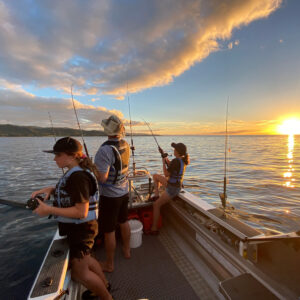After nine years of resistance the government is on track to finally get cameras on-board commercial vessels to monitor fishing activity. Installations are expected to start at the end of 2022 and finish in 2024. We’re encouraging the Minister to initiate the camera rollout as soon as possible.

We know from previous compliance reports and investigations that fisheries officials have been aware of large scale dumping of fish since day one of the Quota Management System. Their ineffective responses since 1986 speaks volumes about the undue influence that quota owners have over Ministry decisions.
Now we have a Minister, Hon David Parker, who is prepared to forge on and ensure that electronic monitoring of commercial fishing is implemented. Cameras are part of the solution to monitor what is happening on-board. Vessel tracking is another element already in place.
In October Fisheries New Zealand issued a document discussing how the cameras might operate, who will pay and which vessels will be included in the rollout. Our New Zealand Sport Fishing Council fisheries team spent a lot of time trawling through the proposals because it’s important this programme gets underway soon.
LegaSea worked with our fisheries team, the New Zealand Angling & Casting Association and New Zealand Underwater Association to submit a joint, comprehensive response on December 6th.
Our team made the following recommendations for the Minister:
- Initiate the camera rollout as soon as possible.
- Include the deepwater fleet and scampi vessels in the rollout.
- Include set net vessels below 8-metres long in the rollout, exempt smaller trailer boats fishing flounder and mullet.
- Include as a priority all trawl vessels operating around the top half of the North Island.
- Ensure all rollout costs are recovered from quota holders.
- Ensure that all catch is accounted for by having all eligible vessels operating their cameras from the time they leave the wharf or anchorage until unloading is completed.
Officials are well aware the deepwater fleet is responsible for the greatest known amount of discards and bycatch. Scampi vessels are known to take volumes of bycatch. It doesn’t make sense to excuse these vessels from monitoring. If anything we ought to double down on this effort due to past difficulties of keeping observers safe at sea for weeks at a time.
Similarly for set net boats targeting species other than mullet and flatfish. The suggested 8-metre minimum length is unnecessarily long. These vessels are the least capable of accommodating an on-board observer so camera monitoring makes sense.
After almost a decade of waiting we want this rollout to be effective against unnecessary wastage and bycatch, and to improve monitoring. Allowing cameras to be turned off if the crew is fishing with a Maori customary permit or recreationally defeats the purpose of programme – to monitor all catch.
Many trawlers operate on the east and west coasts, and some even work off both Islands due to the large Fisheries Management Areas (FMAs). The trawl fleet operating in FMA 1 and 9, around the top half of the North Island ought to be prioritised for cameras. That will give us and the wider public some comfort that dumping and trucking of catch from one coast to another is being managed effectively and that endangered species are protected.
All costs associated with the rollout ought to be recovered from quota holders. It is unfair to expect any of the fishing crews to pay for it when they are already paying rent to the quota owners just to catch fish. In a system where the profits are directed upwards to an owner, so should the costs be likewise directed, all of them.
The Minister needs to be clear. Unless all vessels fitted with cameras are required to have them operating from the time they leave the wharf or anchorage until they unload there is absolutely no point in proceeding with an expensive rollout of electronic monitoring.





